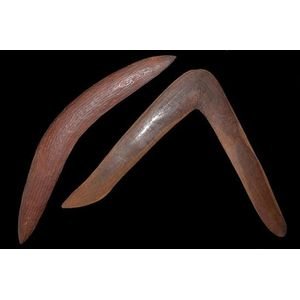Greenstone axe examples Image courtesy of Museums Victoria Collections https://collections.museumsvictoria.com.au
Our friend, Dr John Gardiner, recently sent us his theory on Aboriginal trade. It’s a fascinating read which led me to look more into the Aboriginal trade routes throughout Australia and with the Malyasian Maccassans who in turn traded with the Chinese and along the Silk Road.
Many of my clients have read The Songlines by Bruce Chatwin so are familiar with the complexity, breadth and depth of Aboriginal trade including a greenstone axe-producing quarry in at Mount William Stone Hatchet Quarry (known as Wil-im-ee Moor-ring) outside Melbourne. (Further reading suggestion can be found below).
———————-
By Dr John Gardiner
Recently I heard about how the native guava (bolwarra) is being decimated by myrtle rust, introduced somehow from overseas. The bolwarra has gone from thriving in the Eastern rainforests to being critically endangered in only a few years. Such a wonderful plant too.
This got me thinking about all the other Indigenous food plants we have that are really similar to food plants in Asia and elsewhere. Finger limes, native gooseberries, native grapes, native pomegranates among many others. Experts think that many of these plants were introduced to Australia thousands of years before colonisation and have subsequently adapted to, or been bred for, local conditions.
It could be argued that the plants were already present in Australia before the supercontinent Gondwana broke up, like the family Proteaceae: in Australia waratahs and South African proteas. Or that the plants came by wind, water, or on the wings of birds, bats or insects.
Let’s look at the Kimberley baobabs. Baobabs are only found native in the Kimberley and Madagascar/Africa/Arabia. The African Creation Story of how the baobab came to be upside-down is almost exactly the same as the Aboriginal Dreamtime Story and there are linguistic similarities between African and Aboriginal baobab names. Moreover baobab nuts have high vitamin C and long shelf-life so early Arabian seafarers would provision them to stave off scurvy.
It seems entirely plausible that the Kimberley baobab, and through extension other culturally important plants, were brought to Australia by people purposefully or by accident.
There are other tantalising clues to Australia’s rich historical past. An Ancient Greek coin found in the Wessel Islands off the Northern Territory that may be from pre-fifteenth-century Tanzania, a fifteenth-century bronze Buddha found in Shark Bay. Then there is the introduction of the dingo between 4000 and 8000 years ago or maybe even earlier.
Trade never happens in one direction. So whoever introduced these food plants I mentioned must have gained something in return. There is a papyrus from Alexandria dating to the early first-century C.E. that shows a cassowary. Cassowaries are only found in Australia and the islands immediately to its north including New Guinea. There must have been a trade route by land or sea at this time.
Indigenous Australia has made some amazing technical advances over the millennia. The returning boomerang, circular breathing, ground edge stone tools. Boomerangs have been found in Florida and even in Pharaoh Tutankhamun’s tomb. It has been suggested that various civilisations developed them independently.
Boomerangs were not introduced to Australia: it is known they were invented south of Sydney. The earliest known record of boomerangs in Australia is around 20000 years, similar to the age of the a 23000 year old Polish boomerang made from a mammoth tusk.
I would not be surprised if the knowledge of how to make boomerangs made its way from Australia, across Eurasia, in return for trade in the opposite direction. Australian Indigenous Culture may have been connected to, and contributed to, the rest of the world for a long time.
Two old boomerangs, left: an early stone carved hunting boomerang, Western Australia, right : an early highly curved returning boomerang, made from hardwood, Southeast Australia, early 20th century. Provenance: Lord Alistair McAlpine (1942-2014); a British businessman, politician and author who was an advisor to Prime Minister Margaret Thatcher, he was a lifetime collector in many fields including Aboriginal Art. He was an early collector of the American painter mark Rothko and could easily see the sophisticated aesthetics of Aboriginal Art and artefacts. Image and text courtesy of www.carters.com.au



